TOOLBOX


Welcome to TOOLBOX.
My name is Tim Matiakis, and I am a Denmark-based, Swedish-Greek choreographer, dancer, and artistic director of KINISI—a dance and choreographic project focused around embodied sensemaking, embodied knowledge, and embodied logic.
The text that follows addresses the choreographic method that I developed in the fall of 2022 in collaboration with Forsøgsstationen, with support from Bikubenfonden. It was researched and completed with two consultants, Karen Vedel, associate professor of Theater and Performance Studies at Copenhagen University, and Rachel Tess, dancer, choreographer, and artistic director of Milvus Artistic Research Center (MARC), who provided me with sparring, guidance, structure, and valued insights.
This text and the adjoining videos are my way of documenting and sharing my findings. Although I present this as my toolbox, it does not belong to me. It is informed and influenced by the experiences that I have shared with and knowledge gathered from everyone that I have met and worked with through my years of dancing, choreographing, teaching, and directing.
This text introduces you to the method of investigation, guides you through TOOLBOX, and concludes with a series of reflections and realizations made along the way.
TOOLBOX was originally motivated by a personal intent to critically (re-)engage with the last five years of my choreographic work, physical research, ideas, texts, and classes, in order to understand my own process better, examine my relationship with dance, and create new understandings and insights into how to work with dance and choreography.
The question formulated, was:
Is there a single choreographic method underlying my work? In other words, is there a singular choreographic or physical sensing in the individual elements that inform each other or relate to one another?
This question aimed to provide a flexibility around the end result needing to be a singular choreographic methodology. This created an investigation method that engaged with the different materials as singular entities, with the intention to specify and understand their physical and choreographic potential before making conclusions.
TOOLBOX has emerged at the end of the process, through a conversation with Rachel Tess, creating a web of associations and enlivening the materials under review.
TOOLBOX reveals the possibility to structure the act of dancing into choreographic situations that preserve the experiential sensation and physical holism of being immersed with moving. At the same time, it caters to individual sensemaking and previous individual dance and choreographic history, thereby letting the singular body guide the aesthetics and sensemaking produced, moving away from the hierarchy of a singular body’s aesthetics and logic.
TOOLBOX is not final and static. It is a method that comes alive and further develops with the individual’s engagement as well as the situations and collaborations that it invites.
INVESTIGATION METHOD
TOOLBOX is the result of:
• One week of collecting and organizing the existing material
• Two weeks in the studio, alone
• One week wrap-up
• One week in the studio with dancers/choreographers Anna Pehrsson, Brittanie Brown, and Rachel Tess
• One week wrap-up
• Two weeks in the studio, alone
• A two-day knowledge sharing event at Forsøgsstationen, consisting of both physical sharing with thirteen dancers, choreographers, instructors, performers, and artists, as well as a public discussion with Karen Vedel, introducing what the findings were at that time
• Wrap-up, conclusion, production of video and text for knowledge sharing on KINISI website
Before beginning this process, the consultants and I spent a few days developing the method of investigation.
2 3
1. Select one material. Set a timer for seven minutes. Record yourself doing the material until the seven minutes has elapsed.
2. After seven minutes, answer the following questions. When doing so, use a separate document for each material. Before answering the questions, date the document, so you can keep track of your observations over time.
• What physical experience have you just had? Describe texture, quality, densities.
• What experiential modus does it have? Sensation, relation, emotion?
• How has this material emerged? In what context has it been used until now?
• What is artistically/choreographically interesting about it? What choreographic possibilities does it have? What is it on the horizon of?
• In what context (or several) can it exist? (Teaching, practice, score, choreographic material, choreographic task, choreographic point of departure, etc.)
• What relational/communicative/social/performative potential does it have?
• Has it led to new questions/observations?
• What strategies are you using?
3. Watch the recorded seven minutes and add to the questions, if needed. Name the material and save it in its own folder together with the document containing the answers to the questions.
4. Decide if there is something of interest/new potential that you would like to look further into straight away. In that case, repeat this process. If so, make sure to save the video with a tag in the same folder, so the difference is clear when looking through it again.
5. Continue with the next material. Repeat the process.
6. Return to the same material at least three times before making conclusions.
I deviated a few times from this structure by extending the amount of time I/we used for a singular investigation.
The videos and texts were stored in an overall Dropbox folder, separated into specific folders for each material and each investigation dated, in order to create an easy overview. These folders were shared with the two consultants, so that they could follow the process.
I did not use music or other sound during the process, in order to not let the movement get affected by different musical sources. I deviated from this a few times when I felt it was energetically necessary in order to sustain momentum.
The five parts are interrelated, originating from the category Logics. From there, any possible action can lead to further explorations and investigations. Even though the parts don’t work hierarchically, I will take you through them in the order that they emerged, to create as transparent a structure as possible.
Founded sense: A belief based on and deriving from sensing.
Feeling-tone: Sensing the full processing of the body’s internal state.
will be simplified to: ‘in relation to Logics Extended.’
deriving from Add-ons, Operating Systems, and/or Extraction Methods),’ it
method offers. Instead of writing ‘in relation to Logics (or its versions
Logics Extended: Logics with all the possible versions that the TOOLBOX
TOOLBOX, creating choreographic situations.
Choreographic Concepts: A structure with the ability to include all parts of
material.
Extraction Methods: Excavation of reproducible physical and choreographic
be processed through.
Operating Systems: Filters that Logics alone, or Logics with Add-ons, can
extended physicality, deriving from that Logic.
Add-ons: An accompaniment to Logics which, when added, creates an
embodiment and behavior for the body, creating a distinct physicality.
Logics: State of physical engagement that generate a specific
TOOLBOX
EXPLANATION OF TERMS
Method of investigation
L OGICS ADD-ONS OP E RATINGSYSTEMS E X T R A NOITC SDOHTEM OHC R ECNOCCIHPARGOE P T S 4 5
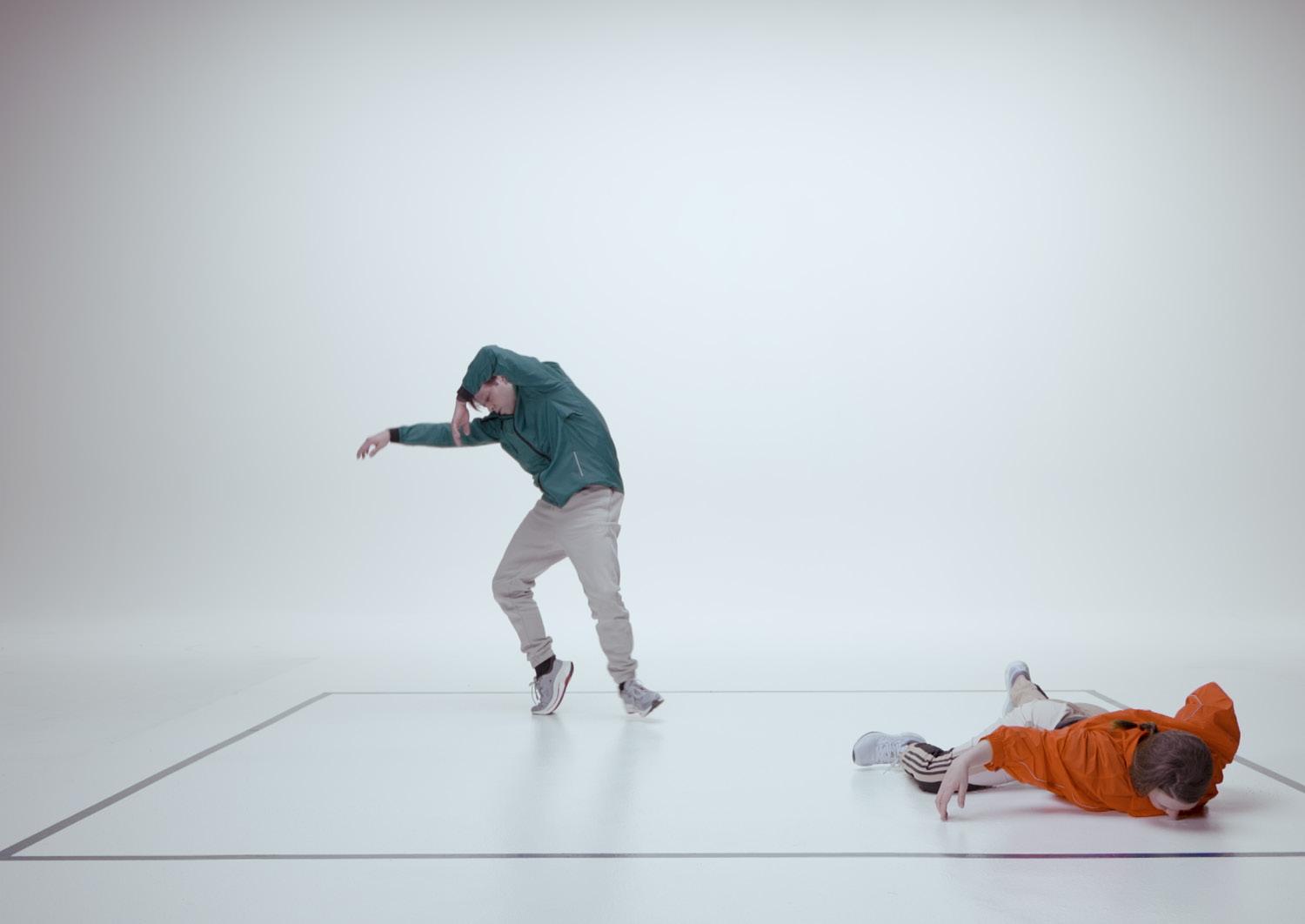
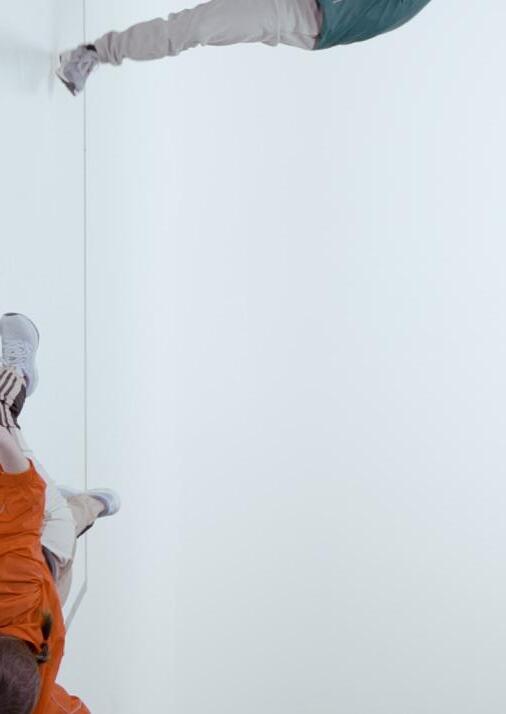
6 7
LOGICS
I define Logics as states of physical engagement that generates a specific embodiment and behavior for the body, creating a distinct physicality.
Each Logic has a set of principles and strategies that creates a sort of weather system that each dancer inhabits, translates, and embodies.
The Logics have the body as the main interest and anchor, and are intended to be self-generative and explored for a period of time, stretching from a minimum of seven minutes to a maximum of one hour.
The Logics differ in physical engagement and aesthetics, and they are based on a mix of inspirations, from a purely functional understanding of the body to a more philosophical understanding of movement and moving.
They are:
Bend – Extend – Rotate
Distance and Proximity
Joint Elbows
Amoeba – Cloud
Appear / Disappear
What is happening now? / This is it
Transformation through Repetition
Swallow
Suction Cups / Pressure
The strategies that follow each Logic serve as guidelines and inspiration; they function as ways to stay engaged over a lengthy duration, and to facilitate the creation of custom-tailored approaches of one’s own.
Strategies are only extracted from and described in the Logics section. When engaging with Logics and/or Logics Extended, it can be helpful to keep track of your own strategies, to build your own library of strategies that work for you.
Some Logics have several versions that were developed whilst working with them. Other Logics have just one version. In the case where there are several versions, I will name them all, to give full insight into the breadth of possibilities that stem from that single Logic.
Bend – Extend – Rotate is based on the idea of the functionality of the joints that we have in our body, which can bend, extend, and rotate. This Logic asks you to engage and explore the basic functionality of the joint in an exploration whereby the whole body is reactive in response to the play that occurs by examining the bending, extending, and rotating of one or multiple joints. The different versions of Bend – Extend – Rotate are:
• Bending, extending, rotating of one arm (my preference was to start with the elbow, but it can be applied to any joint/s in the arm)
• Bending, extending, rotating of two arms
• Bending, extending, rotating of both legs
• Bending, extending, rotating of arms and legs, and any combination that can be produced from there
Some strategies that can be helpful are:
• Allowing the order of the words ‘bend’, ‘extend’, and ‘rotate’ to shift
• Using the joint that you are working with as a point that the rest of the body can move away from and towards
• When it comes to legs, I use the extra words ‘shift’, ‘drag’, and ‘step’ to create more possibilities
– With ‘shift’, I mean shifting the direction that you are facing and/or oriented towards
– With ‘drag’, I mean dragging one of the legs into the centerline
– With ‘step’, I mean stepping out of the centerline
• Sliding softness in feet
• Bending and stretching torso
• Repetition as a way to get reinterested
• Reminding yourself of spatial clarity
• Bridging
See the adjoining video Bend – Extend – Rotate in the section Logics, to get a physical understanding of this Logic.
Bend – Extend – Rotate
8 9
Distance and Proximity
Distance and Proximity operates with the attention placed on the examination of the distance and proximity between points of the body, and the interplay that can occur when the body is put into motion. This Logic asks you to engage and explore the multiple possibilities and ways that the body can organize and coordinate itself in response to the play that occurs by examining these forms of relation. With this Logic, I have primarily focused on the elbows and knees, though you are welcome to apply it to other points on the body.
Some strategies that can be helpful are:
• Moving between sensing, illustrating, and tracking/drawing
• A reliance on the dynamics of the joints
• Changing the density of the space located between two or more points that are in proximity to each other
• Making it literal
• Reading the body as a playful thing
• Stop and go in unfamiliar places to reinvestigate the relationship of proximity and distance
See the adjoining video Distance and Proximity in the section Logics, to get a physical understanding of this Logic.
Joint Elbows
Joint Elbows operates with the idea that the elbows are connected, and that the rotation of the forearms guides the movement of the whole body. It can be seen as a slight physical hindrance that creates new possibilities and explorations, or as a physical game. The residual movement is equally important as the act of rotating the elbow joints.
Some strategies that can be helpful are:
• Use the rebound of the twist of the forearms to add dynamics
• Trace the movement of the hands with your eyes and use the head as an equalizing counterweight
• Flick one of the arms through to be able to move in the same tilt multiple times, and add variation
• Counter-rotate to maintain balance
• Throwing and catching, suspending and releasing
• Letting the rest of the body follow
• Setting up a connection and leading with the rest of the body
• Dropping, holding, and softening
See the adjoining video Joint Elbows in the section Logics, to get a physical understanding of this Logic.
Amoeba / Cloud is based on the idea that the body is able to transform and assemble itself in any possible constellation, organization, and form—and from any point. It asks you to dilute the idea of the structure, architecture, and organization of the body, and tune into the field of multiple trajectories within your body that guide, assemble, and transform—all at once.
Amoeba / Cloud is a way to think of the body as material that can take any shape and form.
An amoeba is a one-celled organism that can transform itself in many possible ways. Clouds have similar transformative qualities, but have a different texture and connotation. The Logic creates different ways to self-assemble and transform, which the body interprets with a slightly different feeling, and therefore a slightly different physicality. Amoeba works with the body as a stretchy and plastic material; cloud has a lighter, more see-through feeling.
Some strategies that can be helpful are:
• Multidirectional: imagine that the body starts moving in different directions at the same time, but none of the directions are allowed to dictate a clear trajectory
• Interruption: when you find yourself pursuing a direction, interrupt it by allowing another direction to emerge
• Keeping a soft, but impermeable edge
• Expanding, softening, and spiraling to access direction
• A sinking quality
See the adjoining video Amoeba / Cloud in the section Logics, to get a physical understanding of this Logic.
Amoeba / Cloud
10 11
Appear / Disappear examines the appearance and disappearance of forms, shapes, and movements that your body creates and recognizes. The idea is that you set yourself in motion and, whilst continuously moving and paying attention to the moving itself, start tuning in to the formation of shapes and forms that your body detects—how they appear out of nowhere and disappear into nowhere. This Logic asks you to examine your relationship to our perceived distinction between form, shape, and movement, and to discover what you and the body recognize as forms, shapes, and movements.
The different versions of Appear / Disappear are:
• Appear / Disappear of forms, shapes, and movements—no pausing. The whole body is transforming and engaging in this exploration (best to start by focusing on one of the three categories—form, shape or movement—and specify for yourself how you distinguish them from each other).
• Appear / Disappear of shapes—sculptural. Let one shape appear and, while tracking it, evolve one movement at a time, until a new shape has appeared.
• Appear / Disappear—mirror. Imagine that you are a mirror that reflects forms, shapes, and movements. They just appear, you don´t create them.
• Appear / Disappear—proprioception. You use a proprioceptive scan of the body that explores the arrangement of the body in specific constellations. As soon as a physical constellation is detected, it dissolves, in pursuit of another recognizable one.
• Appear / Disappear—attention. Track your attention and how it appears, morphs, and disappears, to give space to something else. This version has a different physical frame than the original, as it works more in blocks of attention, where each movement is not tracked as carefully, but the attention to what is going on is the primary focus.
Some strategies that can be helpful are:
• Imposing and allowing
• Maintaining one action, transforming from underneath
• Moving into spaces and passing through
• Placing an anchor point outside of yourself
• Architecture in the room
• The body’s architecture
• Sensing the possible readable value that can be derived from the ´forms and shapes´
• Scanning / dissolving / evaporating
See the adjoining video Appear / Disappear in the section Logics, to get a physical understanding of this Logic.
This Logic has two main branches that follow the same principle, but create a different physical and experiential outcome. In the first, you set yourself in motion and ask yourself the question: ‘What is happening now?’ In the second, you set yourself in motion and say: ‘This is it.’ The aim of the question ‘What is happening now?’ is to produce a sensing of everything that is going on in the moment that the question is asked, trying to include as many elements that can be experienced in that moment and letting this scanning produce the next moment of movement. The statement ‘This is it’ is intended to allow for a settling of the moment, and all it consists of, by recognizing that this is it. This is this moment, and this is this moment, and this is this moment.
The different versions of What is happening now? / This is it , are:
• Ask the question or say the phrase aloud while moving: What is happening now? / This is it.
• When exploring this together with someone else, ask the question or say the phrase aloud: What is happening now? / This is it. Only react to the other person’s voice.
• When exploring this together with others, have at least one person (can also be several) seated or standing, not engaged in the physical exploration of the Logic. It is their task to ask the question or say the phrase, and for those exploring the Logic physically, to react.
Some strategies that can be helpful are:
• Following, suggesting, interrupting, following through, playing
• Whatever is there is allowed to be there
• Relying on previous dance experience
• Trusting that you will find something that will guide your interest
• Allowing inhibitions
• Asking the question `what is not allowed?´ to investigate that tension
• Insisting against and submitting to change
• Affirming
• Looking, sensing, surrendering, allowing, reminding
See the adjoining video What is happening now? / This is it in the section Logics, to get a physical understanding of this Logic.
What is happening now? / This is it
Appear / Disappear
12 13
Transformation through Repetition
Transformation through Repetition is based on the notion that any physical repetition cannot be reproduced as an exact repetition. It is the tracing of the slight changes of each repetition that is the focus of this Logic, in order to allow a gradual transformation that is guided by the act of repetition.
The different versions of Transformation through Repetition , are:
• Pulsing
• Rotating
• Sliding
• Rocking
You set yourself in motion by using your body’s capacity to create a repetitive pulse, rotation, slide, or rocking action, and follow the transformation that occurs through the repetition.
Some strategies that can be helpful are:
• A sensing of the joints and pressure points that are involved
• Mistakes are included in the new
• Shifting focus within the repetition—from areas of the body that are in focus to others, to allow for a more seamless transition
• Listen to the musicality of the movement, and let that guide the transformation
• Let the repetition guide the transformation, rather than a wish to transform
• Notice wishes to change level, but wait to indulge them
• Softening to feel
• Listen to endings and beginnings—are they emphasized or made regular?
• Hyper-attention to transitions and rhythms
See the adjoining video Transformation through Repetition in the section Logics, to get a physical understanding of this Logic.
Swallow is inspired by the quick directional shifts that the swallow bird is able to make while hunting its prey. ‘Suspension’ and ‘drop’ are key elements to allow for the quick directional shifts of the feet and torso. Arms give momentum and can be part of initiating the directional shift. Rotation and counter-rotations of the torso, legs, head, shoulders, and arms are necessary to be able to operate with ease within this Logic.
Some strategies that can be helpful are:
• Drop / recover, drop / re-emerge, drop / rebound
• Slowing down to change into another tempo
• Make irregular
• Listen to suspension
• Pull and push
• Suspending and releasing / Throwing and catching / Directing and following
• Using the weight of the extremities to guide in order to be soft enough to absorb the changing pathways
• Find the creases at the hip, ankle, and knee; use them as shock absorbers
• Directionality
• Make an aerial view of the room, or a topographic map
• Suspension as expansion
See the adjoining video Swallow in the section Logics, to get a physical understanding of this Logic.
Suction Cups / Pressure
Suction Cups operates with the idea that your feet are suction cups that you are trying to unstick from the floor at the same time that there is a downward force that aims to pull your legs under the surface of the floor. The rest of the body is reacting to that, but the focus is on trying to unstick the suction cups from the floor at the same time as they are being pulled down. Pressure has a similar physical feel to Suction cups, but operates with the idea of pressure being imposed from the outside, with your body resisting this pressure by trying to expand, move, and release any part that it is able to, since stillness would create an implosion.
Some strategies that can be useful are:
• Upwards energy in suction cups
• Pulling, lengthening, and expanding of feet and lower legs in suction cups
• A sense of stop-motion film—single frames, sequenced in motion
• Chest clicking into different positions and the variation of that in pressure
• Arms and torso moving in opposition to each other
• Release to redirect and reorganize
See the adjoining video Suction Cups / Pressure in the section Logics, to get a physical understanding of this Logic.
Swallow
14 15

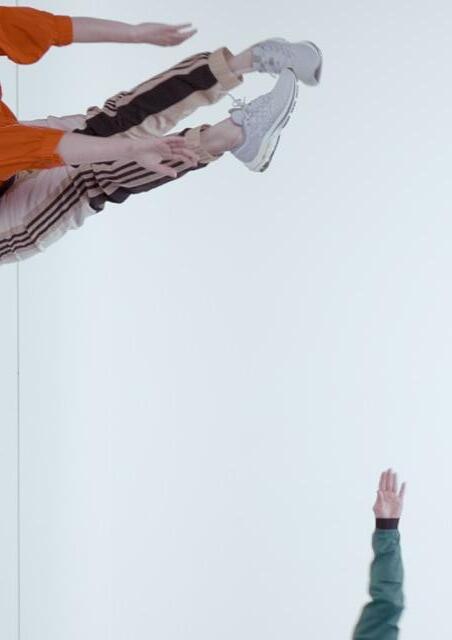
16 17
Add-ons function as an accompaniment which, when added onto an existing Logic, creates an extended physicality, deriving from that Logic.
You can use all Add-ons on a single Logic, and you will thereby get multiple versions of the same initial physical starting point, or add multiple Add-ons for increased complexity.
My experience is that certain Add-ons work better with some Logics, but the attempt of adding them, even the ones that seemingly don’t fit as well, inevitably informs the specific Logic and the sensemaking of it, further.
The Add-ons are:
Magnets
Magnets is based on the idea of magnets sitting on different places on your body, creating an attraction or repulsion of those body parts, depending on which way you imagine the magnets are oriented, as each magnet has a positive and a negative pole. It should evoke a playful exploration of the Logic that it is imposed upon.
See the adjoining video Magnets in the section Add-ons, to get a physical understanding of this Add-on.
Volumes
Volumes is based on the idea that you have a physical volume that can be turned up and down. There are four volumes:
• Only perceived by yourself—leads to a physically quiet and experiential exploration
• Perceived by others—leads to a regular physical activation of the body
• Expanding—guides you into a fuller physical state
• Blow out—guides you into your maximum capacity of physicality and dynamics
See the adjoining video Volumes in the section Add-ons, to get a physical understanding of this Add-on.
Levels
Levels works with the levels of the body in relation to its vertical axis ending in the horizontal axis. There are four levels:
• High—imagine your body operating past its vertical architecture, reaching and working upwards
• Mid-Range—imagine your body operating just under its own vertical architecture
• Low—imagine your body operating very close to the floor, but still attempting to operate with its vertical axis
• Floor—here the axis shifts and becomes a horizontal plane, which your body operates on
See the adjoining video Levels in the section Add-ons, to get a physical understanding of this Add-on.
ADD-ONS
Magnets Volumes Levels Never resting eyes No center Multijoint Match 18 19
Never resting eyes
Never resting eyes works with the idea that the eyes never rest on a single point they are observing, or a single spot within their own sockets. They are constantly in motion, in their sockets and with regards to what they are observing—adding a constant motion for the whole head and upper back area.
See the adjoining video Never resting eyes in the section Add-ons, to get a physical understanding of this Add-on.
No center
No center works with the idea that your perceived center is `melted´ away in order to create a sense of your body as de-centered. This add-on can also expand to include several centers at once, or be placed in other areas of the body than the perceived center.
See the adjoining video No center in the section Add-ons, to get a physical understanding of this Add-on.
Multijoint
Multijoint works with the idea of having more joints than we are dividing the body in. You can either predefine where you would like to place the extra joints and how many, or use it as an overall idea and feeling-tone, which informs the body and adds another texture and articulation to the understanding of the body´s architecture and functionality. It can almost be described as rolling through the body, rather than bending at the joints.
See the adjoining video Multijoint in the section Add-ons, to get a physical understanding of this Add-on.
Match
This Add-on works with the idea of matching different body parts with each other. You can use it as a sort of interference with the natural organization of the body, to create different pathways of organization. You can either predefine which body parts are in focus, and/or where they match, or use it as an overall idea and feeling-tone that informs the body—adding another texture and organization, in relation to the Logic.
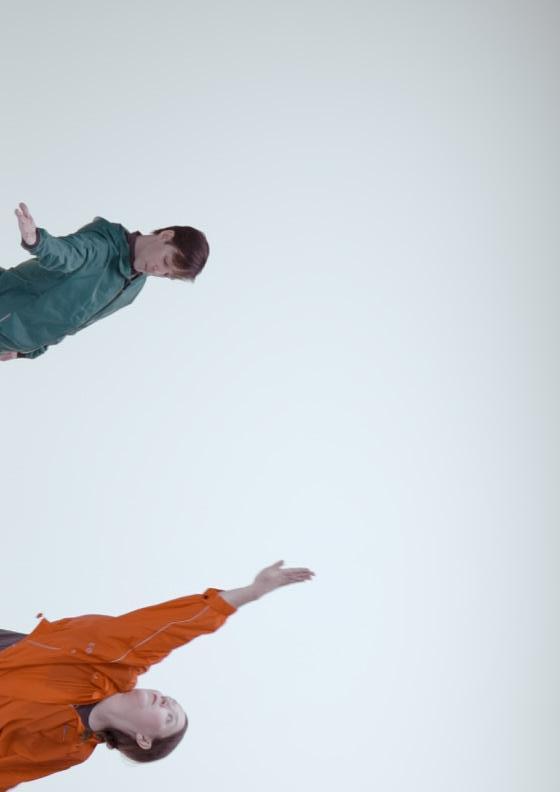
See the adjoining video Match in the section Add-ons, to get a physical understanding of this Add-on.

20 21
OPERATING SYSTEMS
Operating Systems are to be thought of as a filter that Logics alone, or Logics with Add-ons, can be processed through. Operating Systems create a new space that opens up for new ways of relating and working with the Logics and Add-ons. This can create specific choreographic material and/or investigate new potentials within a single Logic.
Each Logic can also be taken though one or several Operating Systems first, to thereafter apply Add-ons.
You can, for example, choose to work with the Operating Systems by tuning into a single Logic and letting it transform with the three existing Operating Systems, thereby creating new variations that can be treated as choreographic material. You can also choose to integrate multiple Logics through the same or different Operating Systems, in order to create diverse physical material that can be assembled into choreographic situations.
The variations are endless and are up to the single choreographic process to determine how to work with these three parts: Logics, Add-ons, and Operating Systems.
There are, as of now, three Operating Systems:
Kinesthetic / Dynamic
Sensorial / Listening
Relational / In-between Bodies
The first Operating System is called Kinesthetic / Dynamic, and it operates by engaging and calling for the kinesthetic, dynamic, and full coordination potential of the body. It works by using the body’s full potential for movement in space, where the focus is on the feedback created from the kinesthetic and dynamic use of the body, producing a heightened energetic sense.
The second Operating System is called Sensorial / Listening, and it operates by engaging and calling for the bodies’ sensory processing, and attuning and listening to the interoceptive information that the body receives, letting the feedback inform the progression. This creates a subtle energetic engagement with the body, but usually a more heightened experiential state, where the common outcome is lower in energy than Kinesthetic / Dynamic, in order to be able to continue sensing and listening.
The third Operating System is called Relational / In-Between Bodies, and it operates by engaging our perception of relation between us and other bodies, and the relation between us and the things around us. This creates instant feedback based on relations and examinations of the space around and in-between us. The Logics tend to morph, becoming more pliable, creating a different kind of organization of the body, and the space the body is moving in, together with the other bodies that are sharing that space.
Operating Systems are different to Logics in that they invite for a processing of the physicality developed with Logics, through kinesthetic, sensing, and/or relating strategies. Putting the Logics through the Operating Systems should feel like changing a frame of mind, or switching a channel.
The difference between Operating Systems and Add-ons is that Add-ons are similar to shades of a color that can be added on top of a Logic, where the Logic is a color and the Add-ons are the variations that can exist within that color. Operating Systems can, in this analogy, be compared to frames that change the basic physicality, feeling, and look of the Logic, and invite us to re-examine and re-interpret the fundamental physical and experiential understanding of each Logic (with possible Add-ons).
See the adjoining videos What is happening now? / This is it, Transformation through Repetition, Swallow with the Add-on No center in the section Operating Systems, to get a physical understanding of the Operating Systems.
22 23
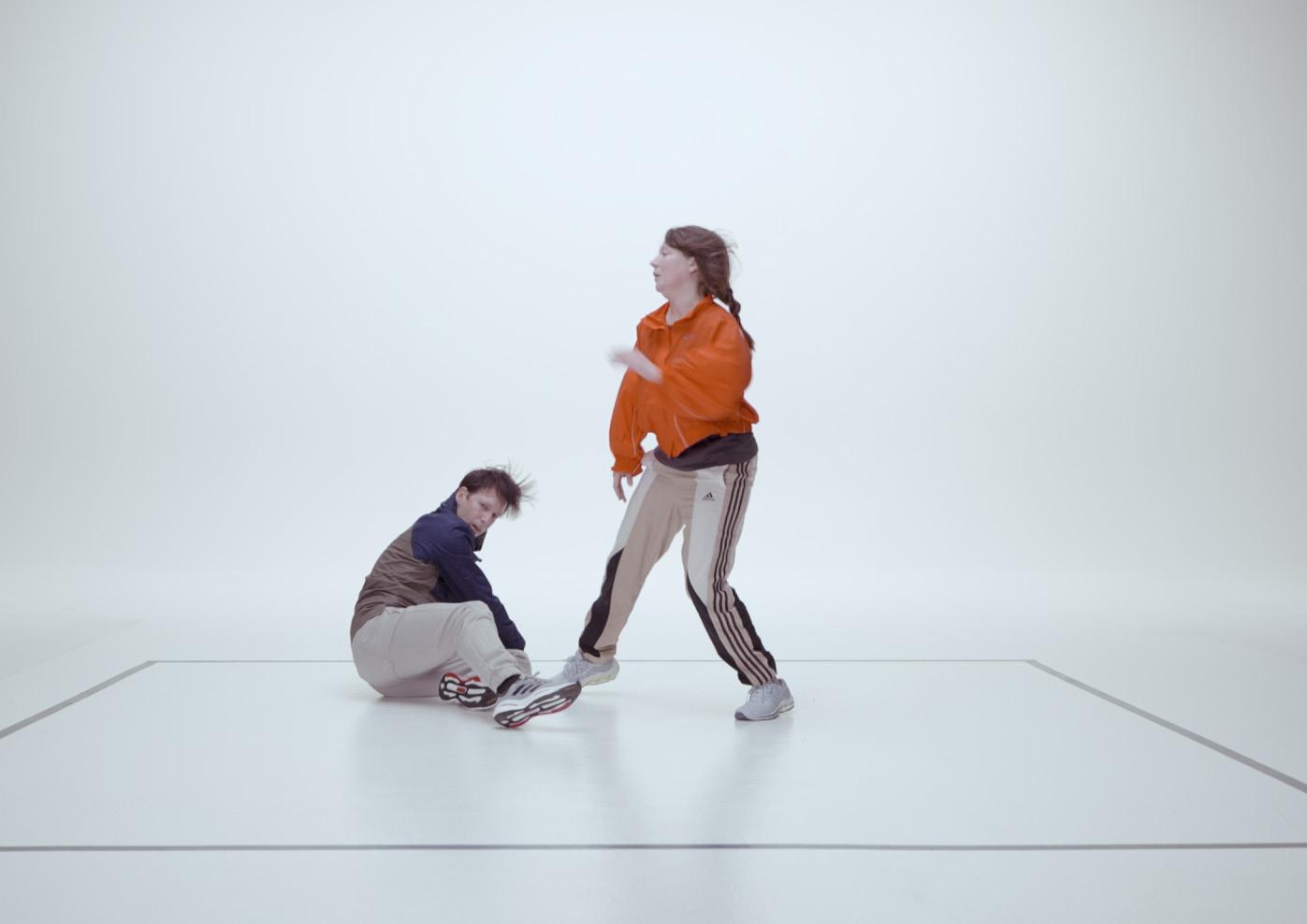
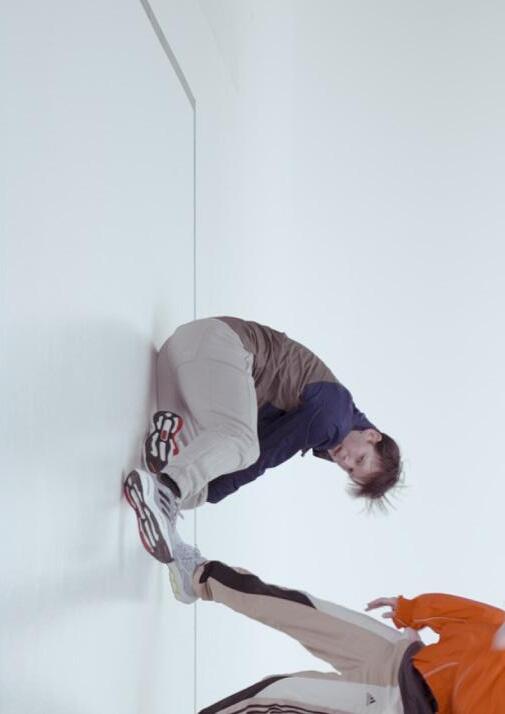
24 25
EXTRACTION METHODS
Extraction Methods are a distinct part within TOOLBOX aimed at the excavation of reproducible physical and choreographic material. This can be a phrase, a score, or a set relation to the room and others.
Extraction Methods are intended to create a frame around extracting the information produced by Logics, Add-ons, and/or Operating Systems, whereby the act of moving and making sense while moving stays intact.
You engage with the Extraction Methods by diving into a Logic/Logics Extended and, after fully sensing its specific physicality and felt experience, you add an Extraction Method on top to extract and create reproducible information. This information can thereafter be used as choreographic material.
When the extraction process is completed, you can also choose to add the same Logic on top of the extracted material and re-experience it, albeit this time with an underlying map of information, guiding the trajectory and unfolding of movement. This can also be done using a different Logic than the original. The Extraction Methods
Cause and Effect
Cause and Effect is based on the idea that any action has a particular effect. It works with a set of five words that relate to ways of being with the body, that become a sieve through which the Logic is filtered.
In its simplest form, each word creates a singular motion with the body that, after being extracted, is used as the new starting point of a physical configuration to proceed from. A threading of movement happens, that is always in relation to the Logic/Logics Extended, at the same time as each word creates a new situation for the body to engage with and extract from. This can, of course, also work as a score, where it is not a singular movement, but a situation of moving that is extracted and threaded together. When a full extraction has happened, there are a few possibilities described below, to create variations of the extracted phrase or score.
The words are: Rotation / Articulation / Expansion / Elevation / Implosion.
1. Set yourself in motion with a Logic/Logics Extended and start using these words to extract physical situations, movements, or a collection of movements. As soon as a situation, or movement(s) is/are extracted, it becomes the starting point for the next word. Repeat this sequence five times to extract a phrase of movement or a score. No actions or movements can repeat.
2. Repeat the full sequence created, and repeat every third movement
3. Repeat the version from the second step, but remove every fourth action/ movement(s), and create links between the actions where something is removed
4. Repeat the version from the third step, and reverse every seventh action/ movement(s)
5. Repeat the version from the fourth step, but add a suspension (in the body or in time) for every ninth action/movement(s)
At the end of these steps, a choreographic phrase/situation has been created, that—even though it is threaded one movement/situation at a time—will not, through the usage of the steps, follow a linear dramaturgical progression. The possibility of stopping after your choice of steps, and thereby not completing the five steps, is also there.
Instant extraction
Instant extraction is used to bypass the analytical and systematic processing of the brain, to extract situations/movement/s that are as close to the feeling of an open practice as possible.
With Instant extraction, you choose a Logic/Logic Extended, engage with it and, when you recognize it on your body and feel that you are in a state of flow, you start by instantly extracting material. The process should be rather speedy and quick, to rely on physical sensemaking and block analytical thinking. The body races ahead, making decisions with a feeling of excitement and eagerness.
You extract something that feels like it makes physical sense, is interesting to you, or has a specific feeling-tone, to create a chain of extracted movements or situations—a sequence, phrase, or score.
You can restart as often as you wish.
Cause
Effect Instant extraction
the
Topography Memory Solid / Liquid / Gas 26 27
are:
and
On
count of five
The material accumulated can be used as choreographic material or processed further, if desired, to create new versions, using Add-ons, Operating Systems or other Extraction Methods. This last option allows for the extraction of material to be used as a base for further exploration.
The aim with Instant extraction is to ease the process of extraction, from a serious process looking for interesting choreographic material, to a game that generates information through a state of excitement and physical flow.
On the count of five
On the count of five is an Extraction Method that uses an irregular (for dance) time signature, where a Logic/Logic Extended is chosen, and the extraction happens by adding the time signature on top of it, and trying to make situations/movement(s) happen that can fit within that time signature.
Adding several extractions in a row usually creates an unusual, yet specific, timing of the body. This Extraction Method can also work with other atypical time signatures.
Topography
Topography uses paper and/or cardboard to build an imaginary topography that the body physically interprets and extracts information through.
You engage with Topography by using blank papers, discarded newspapers, and/or cardboard to create a 3D imaginary topography, seen from above. Once completing this task, you engage with a Logic/Logic Extended, and interpret the Topography through that Logic/Logic Extended. How you choose to interpret your selected Logic/ Logic Extended, through your topographical construction, is individual. This extraction can create a set phrase of movements, a live tracking of the topography, and/or a score that can be used as choreographic material.
Another version of Topography has you engaging with a Logic/Logic Extended and, only after a finished practice, creating a Topography from the memory of the spaces you have traveled through and the interactions had. This version traces the experiences through memory, to thereafter create a topographic map of it.
Once you have your topographic map, created from this tracing method, you can use elements from it as choreographic material or re-engage with the Logic/Logic Extended, and create a new topographic extraction. With this version, the extraction derives from an open practice of a Logic/Logic Extended, filtered through memory, to create a Topography that a new extraction happens from, creating an interlinked loop. Topography aims to create a new examination of a Logic/Logic Extended, through a plane of vision that shifts your perspective, and thereby your engagement with your vertical and horizontal axis, prompting an imaginative expansion, a bigger awareness of the space you are inhabiting, and a layer of tracing through memory (tracing method).
Memory
Memory uses the act of remembering as the tool of extraction. With Memory, you engage with a Logic/Logic Extended, or a score composed of several Logics Extended, for a minimum of thirty minutes. After the time has elapsed, you try to recreate things you experienced from memory. The long time frame invites a fragmentation of memories and materials, in order to create a collage of materials, rather than a representation of events. What you extract can be actual movements, spatial relations, situations, connections, etc.
You can either add the memories arising one after another as they emerge, or create an overview of them first, and then compose them together, or use a randomized principle of selection.
You can expand Memory by allowing for an extraction of words (if you spoke), thoughts, emotions, sensations, etc. that you remember while engaged with the Logic/Logic Extended. These can serve as an extra layer of information that can be matched with the physical, spatial, relational material extracted, or as a separate extraction to be used as an equal component in the final composition.
Solid / Liquid / Gas
Solid / Liquid / Gas stems from water’s ability to change state, depending on the temperature, to be either solid, liquid or gas.
With Solid / Liquid / Gas, you engage with a Logic/Logic Extended, or a score of several Logics Extended. By bringing the three states into your consciousness (one at a time), and engaging with them with your body, imagination, and association, you create a physical translation of each state, through the Logic/Logic Extended. The interesting thing with this Extraction Method is that, even though the starting point is the same, the materials emerging from the extractions are significantly different through their physical translation and the individual’s imagination and association to the three states/words.
The single extractions can be used as choreographic material, or be fused together with the other extractions, adding parts from all three extractions into a final phrase, situation, and/or score. You can also apply Solid / Liquid / Gas onto several Logics Extended, creating a multiplicity of varied extracted choreographic material or fused versions.
With Solid / Liquid / Gas, the possibility is given to create three different extractions from the same starting point, where each extraction offers a distinct physical translation.
28 29
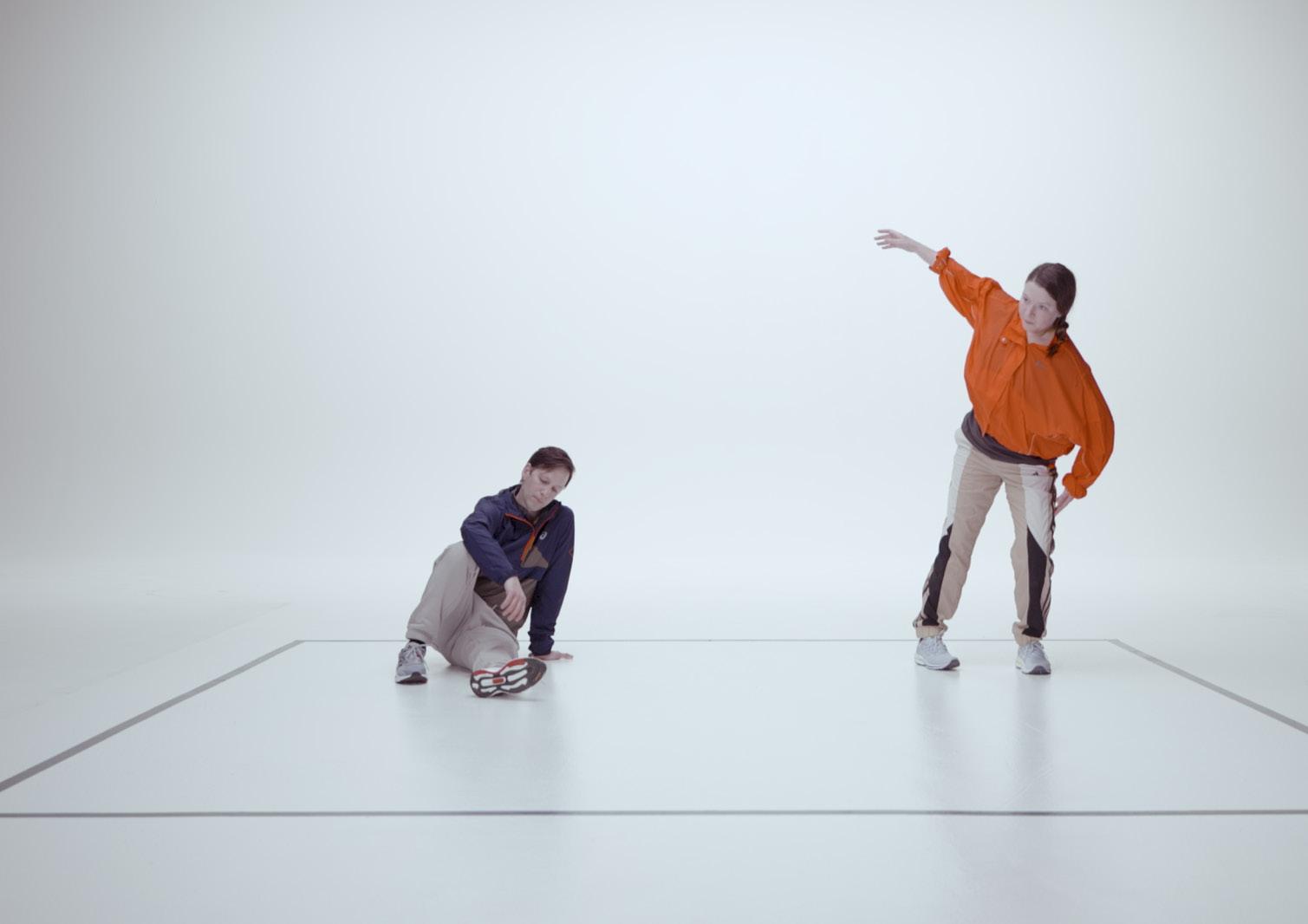
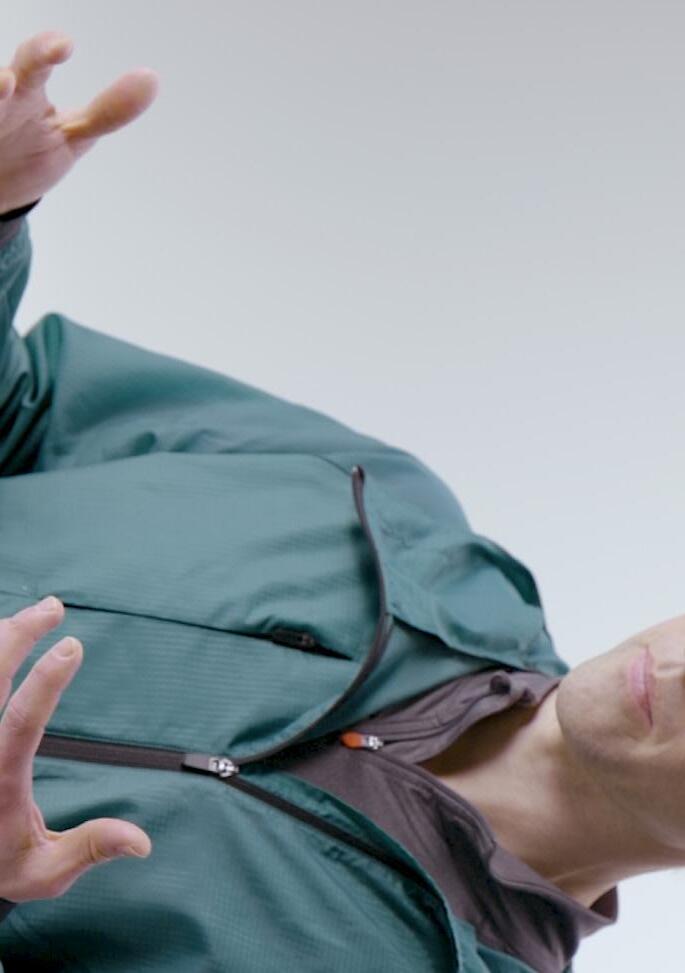
30 31
CHOREOGRAPHIC CONCEPTS
Choreographic Concepts describe structures that have the possibility to include several Logics/Logics Extended as their elements.
Choreographic Concepts are ways of interacting with the multiple parts of TOOLBOX in a choreographic and compositional investigation, to generate information that thereafter can be used to create choreographic situations and structures.
Choreographic Concepts emerged from working with the creation of TOOLBOX, where some Logics spontaneously doubled as overall concepts, creating a circular relationship to the five parts of TOOLBOX.
You can engage with Choreographic Concepts by choosing one of the described concepts below, and thereafter allow the parts of TOOLBOX to either emerge through body memory, or arrange a score and an order for the materials you want to investigate to then engage with a Choreographic Concept.
The Choreographic Concepts are:
Appear / Disappear
What is happening now?
Everything all at once and at the same time
Transformation through Repetition
Opposing Intentions
Distance and Proximity
The discovery of the dual functionality of Appear / Disappear as a physical practice and as a choreographic concept prompted the formulation of Choreographic Concepts as a distinct part of the method detailed in TOOLBOX.
You can engage in an open practice, where you dive into a chosen Logic/Logic Extended, and tune into your sophisticated body memory that discovers traces of other Logics/Logics Extended and let those subtle shifts drive the progression of your practice. This can, over time, build a catalog of compositional possibilities that can work as choreographic situations.
You can also engage with a predetermined selection of Logics/Logics Extended, and allow them to appear and disappear, as frequently as they want and stay for as long or short of a time as they wish. The switches between the Logics/Logics Extended are usually more abrupt in this version.
What is happening now?
The Choreographic Concept What is happening now? is closely related to its Logic, and asks you to engage by posing the question to the information arising and letting that guide you further in its choreographic potential.
With What is happening now?, you engage with a single Logic/Logic Extended, and, by posing the question, or by allowing the question to be present in your consciousness, new material and information arises. Thereafter, this new material and information can be distilled, to create new marks and versions of the chosen Logic/Logic Extended, you have engaged with.
From there, you can engage with these new marks/versions again, creating a map/ score of different possibilities and evolutions, arising from the Logic/Logic Extended. The marks/version can be movement related, but also spatial, relational, situational, sense-, or vocal-based.
Everything all at once and at the same time
Everything all at once and at the same time asks for a more randomized and multilayered engagement with the parts of TOOLBOX. Can multiple Logics or their variations be present in the body at the same time? How do you operate that complexity? How do you navigate it? How do you choose?
This Choreographic Concept invites a disturbance of the more linear progression of materials emerging, replacing each other or evolving, described in the Choreographic Concepts Appear / Disappear and What is happening now? It creates a game that can surface other types of physicalities and engagements by overloading the body’s ability for complexity.
Appear / Disappear
32 33
Transformation through Repetition
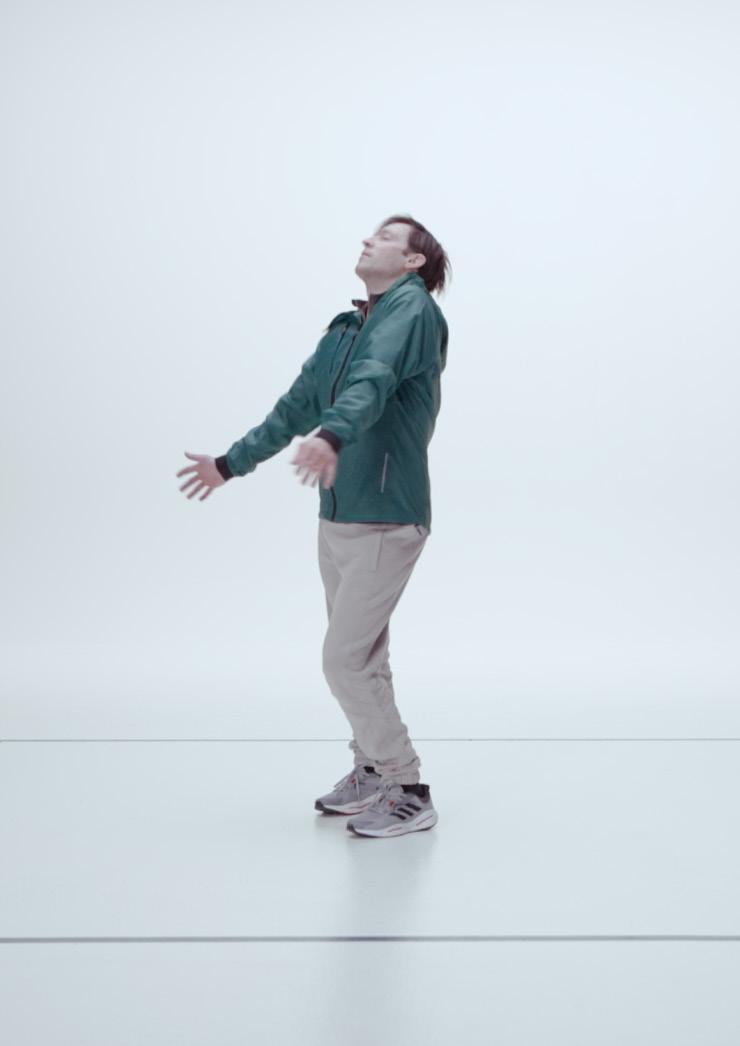
Transformation through Repetition functions as an overall umbrella of how to operate with several Logics/Logics Extended, not by using a physical repetition as with the Logic, but by creating a repetitive situation that, over time, transforms and develops, or creates a momentum to engage with the next Logic/Logic Extended. This Choreographic Concept has proved useful with material that has emerged through the Extraction Methods, and provides the option to use extracted and reproducible material in an ever-unfolding progression and investigation of how, when, and what they can transform to over time.
Opposing Intentions
With Opposing Intentions, the intention of a certain action is opposed. This can, amongst other options, include physical trajectories, a choreographic progression, a set score/phrase, directional shifts, relational situations etc. that arise from working with Logics/Logics Extended. This Choreographic Concept can present a choreographic process, with more possibilities than the ones already imagined, and create a friction and investigation between intentions and the newly emerged possibilities.

Distance and Proximity
Distance and Proximity works with the notion of using distance and proximity as an investigatory parameter in relation to a given determining physical context (e.g., a studio with other participants present). Distance and Proximity offers a space for investigation, where you engage with a Logic/Logic Extended, or several Logics/ Logics Extended, and, by applying the concept in everyone’s consciousness, new information of how to operate with several bodies in specific contexts/spaces will emerge, without having to pre-arrange situations, relations, or spatially-fixed points. It differs from the Operating System Relational / In-between Bodies, in the fact that, as a Choreographic Concept, it invites an investigation to extract new relational information, which can include several Logics/Logics Extended, participants, space/ architecture, sound, scenography, costumes, etc.
34 35
My main question for this method development project was: Is there a single choreographic method underlying my work? In other words, is there a singular choreographic or physical sensing, in the individual elements that inform each other or relate to one another?
I hope TOOLBOX demonstrates the fact that, despite the materials and inspirations being varied and the parts of this method multiple, it assembles and finds its organization under one choreographic method that creates relations across its different parts, where the different parts of TOOLBOX inform one another in the unfolding of movement, dance, and choreography.
TOOLBOX is a map that can be navigated, distilled from the physical explorations and experiences they have offered. Words and systems cannot translate the experience of moving and movement alone, but, with TOOLBOX, a choreographic method has appeared, creating interlinked paths between accumulated embodied knowledge.
TOOLBOX is a choreographic method aimed to be explored, in order to create a clearer physical sensemaking that can lead to choreographic explorations and works.
This has, for me, created a more founded sense and continuous belief that embodied knowledge and sensemaking leads the way for physical research, dance, and choreography.
Observations
The observations that follow are more specific conclusions, relating either to distinct parts of TOOLBOX or explicit reflections that arose during the process.
Method investigation questionnaire
The method investigation questionnaire and the structure of investigation (always starting with physical practice, self reflection through answering the same questions by writing and sharing those reflections verbally) yielded several observations.
1. The discussion that followed the written reflections became very nuanced and several unexplored perspectives emerged that dealt with the experience and sensemaking of the body, generously sharing those observations/thoughts/ experiences without creating different positions of ‘for’ and ‘against’ what was being investigated.
2. Over time, a common language emerged that created connections that traveled through the materials investigated and the people investigating them, creating new ways of referring to and engaging in discussions.
3. When revisiting the answers, sometimes with several weeks in-between, the embodied feeling of working with the different materials was instantly recreated, allowing a continued exploration stemming from the last engagement.
4. How to progress seemed to emerge by itself, after a session of physical practice, self-reflection, and sharing. This created a transparent continuation of investigation between all participants and an added investment in the further exploration.
This method of investigation seems to carry the potential of being inclusive of diverse physical expressions and different understandings of one singular investigation that, over time and through reflection, discussion, and language, starts creating a shared understanding—physical and cognitive—that informs the material and the work further, without the need of unification, or the relinquishing of one’s preferences.
Body Memory
The body started remembering subtle recognitions of the felt sensation of the different materials. After a while, it could guide itself in open explorations or concrete attempts (e.g., working with Choreographic Concepts). The different progressions seemed to happen just through the act of dancing and being in movement. The managing modality of trying to figure out how and when to progress, how long something should last, shifts, etc. seemed to have been stripped away. This left space for deep explorations that, through body memory, created self progression.
Operating Systems
Appear / Disappear was supposed to be cut as a material after the initial first two weeks in the studio, since, when first re-examined, it didn’t fulfill my predetermined idea of generating a specific dynamic engagement of the body, as previously experienced.
CONCLUSION
36 37
At one of our consultation meetings with Karen Vedel, I expressed my frustration with the material, as I found it ambivalent, confusing, and unclear. Karen had been following the work in the studio by looking at some of the videos I was uploading in the Dropbox folder. She expressed that the material was very interesting to her and encouraged me to bring it into the studio with Anna Pehrsson, Brittanie Brown, and Rachel Tess, which was the next stage in the process.
Following her advice, the reflection was made that it was less important what the material felt like when engaging with it, but what it could do in a choreographic situation. I remember Anna stating that, if the wish was to create a confusing situation for the performers and the audience—a moment of suspense without real progression, then this material would be well suited.
This shifted my thinking with regards to what it was I was looking for with the individual materials, which ultimately resulted in the formation of the Operating Systems part. As my perspective moved from looking for dynamic engagements with the materials to seeing the materials as self-generative behavioral systems for the body that operated with their own individual Logic, the observation arose that Operating Systems could change their modality.
Dynamics, sensations, and relations created a structure for this new part in TOOLBOX, where the initial Logics did not need to fulfill all imaginable quotas in their original form.
Extraction Methods
I have previously pondered the question of how to create reproducible material that derives from the act of dancing, but that is not predetermined by a singular body’s aesthetics and physical ability.
I have tried for several years to identify strategies for this, as I find reproducible movement and situations having another set of qualitative possibilities within a choreographic work that interests me.
While working with TOOLBOX, I managed to find a way where previous and new methods of extraction found a way to relate to the specific physical environments produced by the Logics, Add-ons, and Operating Systems. Previously, I had worked with Extraction Methods as separate entities that produced physical and choreographic material that, thereafter, could be altered, arranged, and fit to a context.
With TOOLBOX, it became clear that, if I applied Extraction Methods on top of an already existing Logic/Logic Extended, the physical starting point and behavior of the body was specific and embodied, so extracting material that can be reproduced from it felt more rich, more specific, and in relation to the physical starting point.
This, in turn, created a traceable relation to the initial physical exploration that didn’t feel reductive in relation to the act of dancing and the rich information, complexity, and experiences that dancing can produce.
Choreographic Concepts
Choreographic Concepts emerged as a part of TOOLBOX during the week working with Rachel Tess, Brittanie Brown, and Anna Pehrsson.
What emerged in this interaction and through the investigation process was the realization that some Logics could double as overall Choreographic Concepts, whereby multiple Logics, Add-ons, Operating Systems, and Extraction Methods could come into play.
This excited me, as it created a circular relationship to the elements of TOOLBOX, but where the Choreographic Concepts were born out of the embodied engagement with the Logics/Logics Extended.
The body´s sensemaking
The body’s way to create sensemaking through moving and movement is an important process of constant re-discovery. The body’s self-organization, memory, coordination, sensing, knowing, and experiencing is another operating mode than cognitive processing.
The body’s ability to make sense of a variety of different impulses, processes, times, and states in order to structure, remember, coordinate, and extract information that can be cognized, etc. is, for me, a sense of constant wonder, appreciation, and curiosity.
Sharing
The actual process of sharing the information accumulated in different forums and at different times has been hugely beneficial for the creation of TOOLBOX. Sharing observations, results, and questions with the consultants; sharing and engaging in an exchange with other choreographers, dancers, performers, and artists; having a sharing workshop; capturing the accumulated knowledge on film; and, finally, creating this publication, has both unfolded and structured the information generated. Each of these stages has informed the work further, created clearer understandings, and clarified how to engage and share the choreographic method TOOLBOX, so that it can be accessible for others interested.
38 39
Special thank you to the two consultants on this project, Karen Vedel, associate professor of Theater and Performance Studies at Copenhagen University, and Rachel Tess, dancer, choreographer, and artistic director of Milvus Artistic Research Center (MARC).

Thank you as well to the dancers and choreographers Anna Pehrsson and Brittanie Brown, the twelve dancers, choreographers, performers, and artists who joined the physical sharing of this method in November 2022 at Forsøgsstationen, Mathias Broe for directing and editing the films and Phillip Jørgensen, who was DOP (Director of photography), Benjamin Robin Graahede for graphics, layout and visual identity, Jacob Lindblad for web design and Alex Fisher for his help with editing and proofreading.
A big thank you to Bikunbenfonden and Forsøgsstationen for their support, without whose support this project would not have been possible.
Thank you for your interest in TOOLBOX. I hope that it can be useful in your own sensemaking.
Tim Matiakis Artistic director of KINISI

Thank you
40 41
















